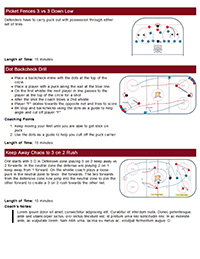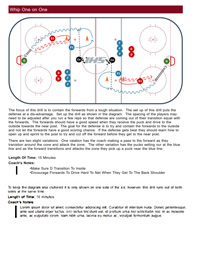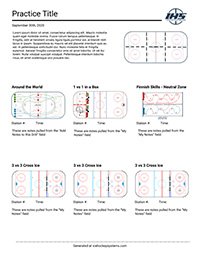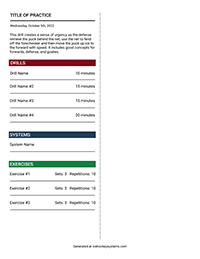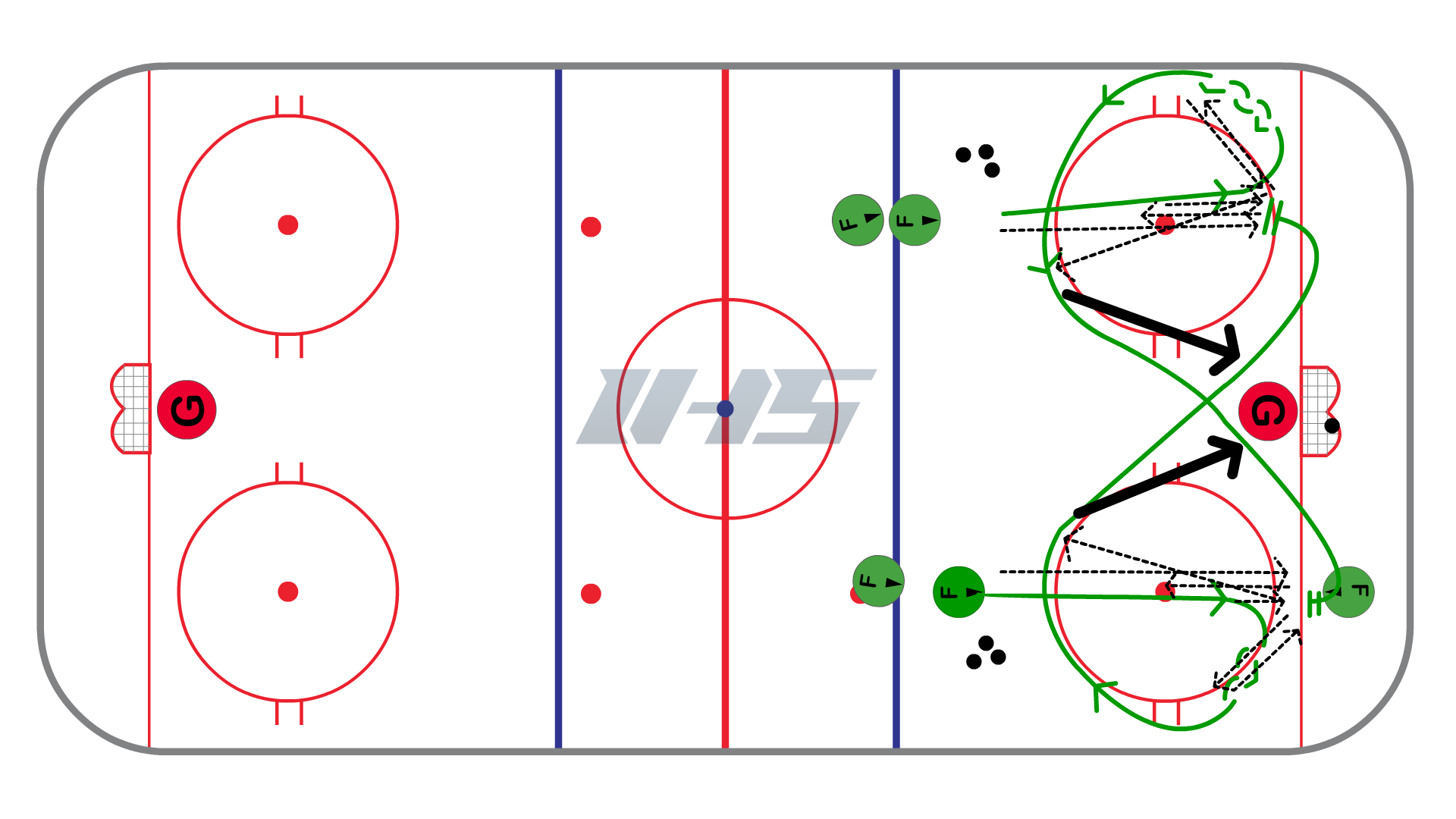
Practice B
Practice B

Continuous One Touch Shooting Drill
This is a good half ice hockey drill that works on one-touch passing, transitions, quick shots, and following shots to the net. To set up the drill place one player along the goal line in-line with the dots. Place two lines just inside the blue line also in-line with the dots, these two lines have the pucks. The first player (Player 1) in line will make a pass to the player on the goal line (Player 2) and skate directly at them. The two players on-touch the puck back and forth as many times as possible. Once Player 1 gets below the dot they transition towards the wall and facing Player 2. The players continue to one-touch the puck as Player 1 skates up the wall, around the top of the circle, and into the slot. When Player 1 receives the puck in the slot they take a quick shot and follow their shot to the net. After the last pass Player 2 will also go to the net looking for a rebound. Player 1 then continues to the other side along the goal line and becomes Player 2 as the drill now starts from the other side. The original Player 2 now goes to the end of the line.
Coaching Points
- Players should make flat passes with soft hands.
- Slapping the puck results in in-accurate passes and wobly pucks.
- Players should transition while facing the puck at all times.
- Receive and shoot in one motion when in the slot.
- Make sure both players follow shots to the net.
Offensive Blue Line Drill
The offensive blue line hockey drill works on a couple of offensive techniques that defense can use in the offensive zone. To set up the drill, the forwards split up into each corner with the pucks. The defense line up just outside the blue line along the boards. F1 starts the drill by passing to D1 at the point and then sprinting to the front of the net. D1 receives the pass and walks the puck to the middle of the ice for a shot on net. Defense should focus on moving their feet and controlling the puck with their heads up as they move to the center of the ice. The shots should be low and use F1 in front of the net for a screen or deflection. F1 should always be in a position to make it hard for the goalie to see the shot. Aftet the shot F1 sprints back to the corner to retrieve a puck and carry it up the wall. D1, after they shoot tranistions back to the boards and receives a drop pass from F1 along the boards. D1 and F1 overlap as D1 skates deeper into the zone and looks to give a pass back to F1 in the hight slot.
1 v 1 Angle Around The Net Drill
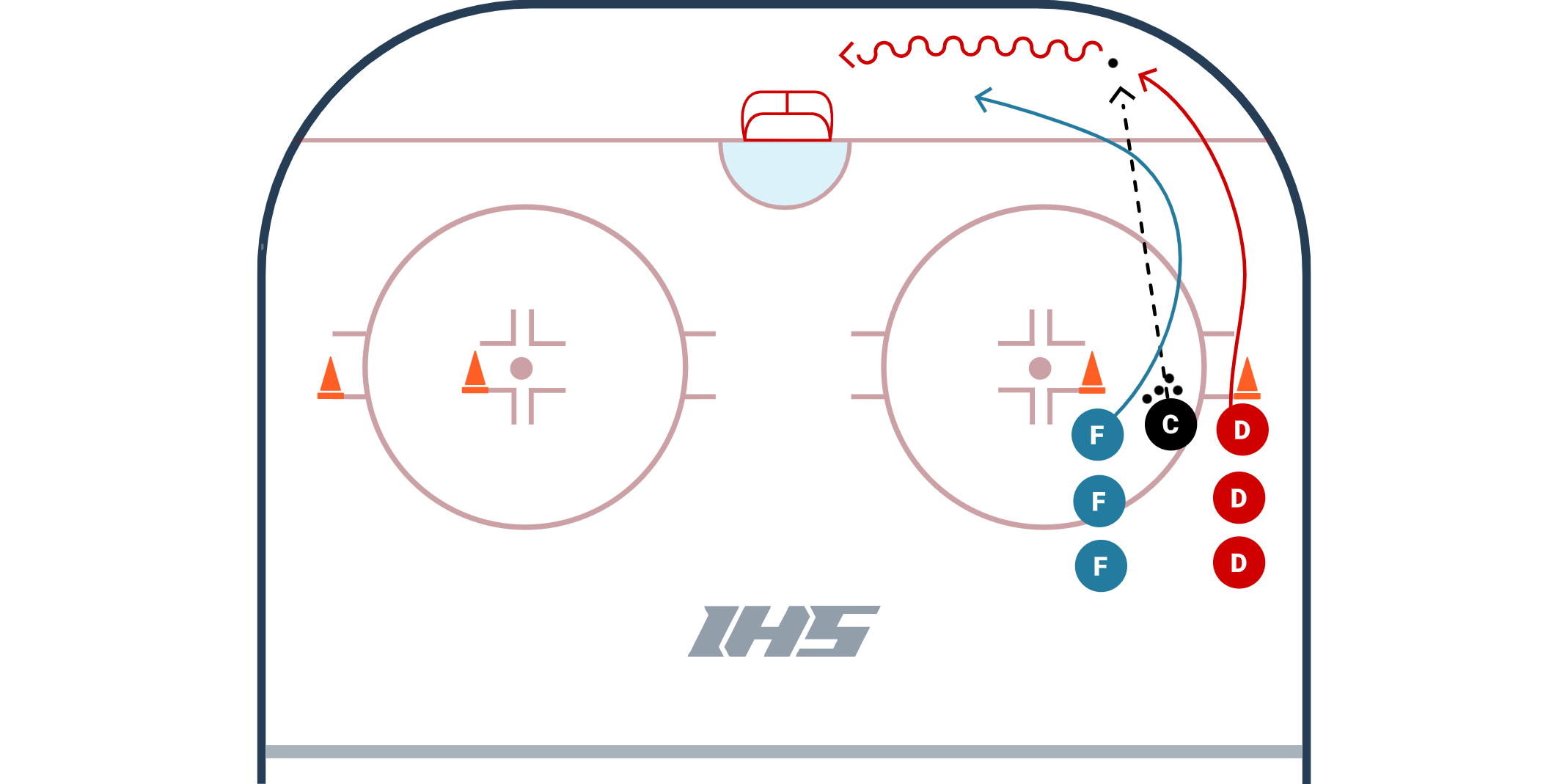
The 1 v 1 Angle Around The Net Drill is an excellent drill to practice forechecking angling for forwards and puck retrievals for defencemen. Forwards and defenceman should get reps at both positions.
Drill Objective: The goal of the game is for the defenceman to collect the puck and skate the puck through the cones. They can go in front of or behind the net. A forward can score a point by stripping the puck from the defenceman and scoring a goal on net. It is a draw if the puck goes out of play. The game starts for the defenseman when the coach chips the puck into the corner. When the coach bangs his stick on the ice, the forechecker starts.
Angling Coaching Points:
- Stick on the ice (to help you angle, intercept a pass, or go stick on stick to take the puck away).
- Match the speed of the player you are chasing.
- Take a proper angle (as pictured in the diagram) so the player can not easily turn back up ice.
Puck Retrieval Coaching Points:
- Look over your shoulder to see where the pressure is
- Retrieve puck at an angle. This will allow you to keep your speed up while you collect the puck.
- Use deception to shake off your forechecker. Use your skates, hips, shoulders, head, or stickhandle maneuvers to make the forechecker think you are doing something else with the puck.
Variations:
- Can be set up as a station, on half-ice, or on a studio rink.
- The coach can give the defenseman a smaller or larger head start.
- Can move the cones to be further away (so there is more skating) or so the goal is larger or smaller to skate through.
- Can add a goalie.
- Can give an extra point to the defenseman for making a pass to a player or coach that is breaking out.
Shoot Puck off goalie, have goalie deflect or leave puck behind the net for the D.
Send D on puck, forechecker on stick tap.
Progress to 2v2 w/ zone clearing.
D clears the blue line, makes 1 pass on the other side, then comes back as Offense
Go Go
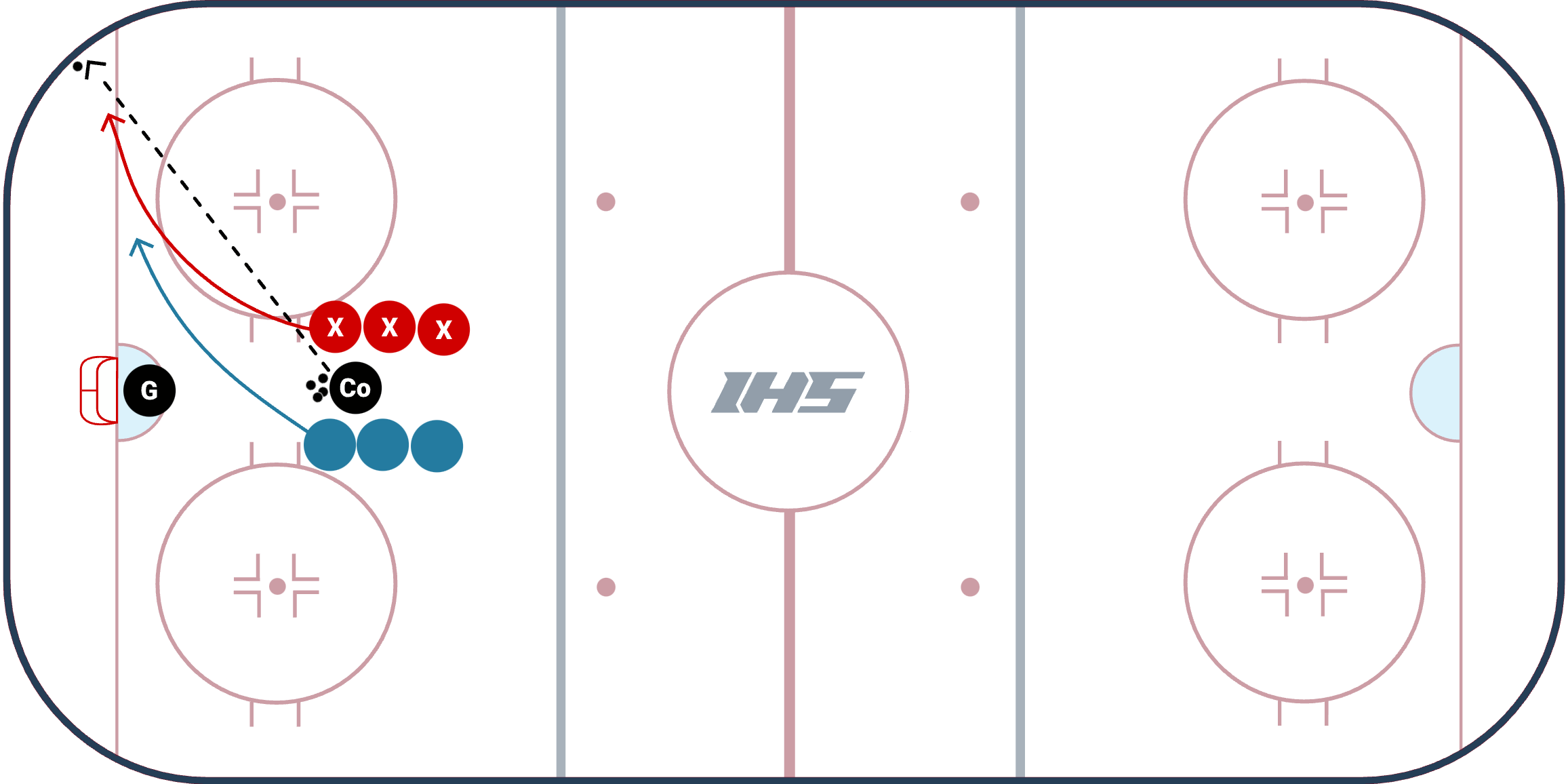
The Go Go from TJ Manastersky, the Head Coach of Brock University, is a high tempo small area game turns into various situations: 1v1, 2v1, 2v2, 3v2, and 3v3. The game practices down low defending along with puck protection, puck support and attacking down low. Players in line need to be ready to jump into the game when the coach yells go!
Setup
- On the whistle, the coach chips the puck into the corner to start a 1 v 1.Whichever side the coach chips the puck into, that team will be on offense.
- Every time coach yells "Go" the first offensive player in line jumps into the play. The next "Go" will have the next defending player in line go. Alternate lines with each "Go."
- This game turns into various situations: 1v1, 2v1, 2v2, 3v2, 3v3, 4v3, etc.
- The offense tries to score while the defending team tries to skate the puck over top of the circle to end the rep.
Coaching Points
- Offensive players first to the puck should practice puck protection and cutting the hands of the defender.
- Players in line that are called into the game need to jump to support their teammates and communicate to let them know where they are.
Shooting Off The Pass - Corners
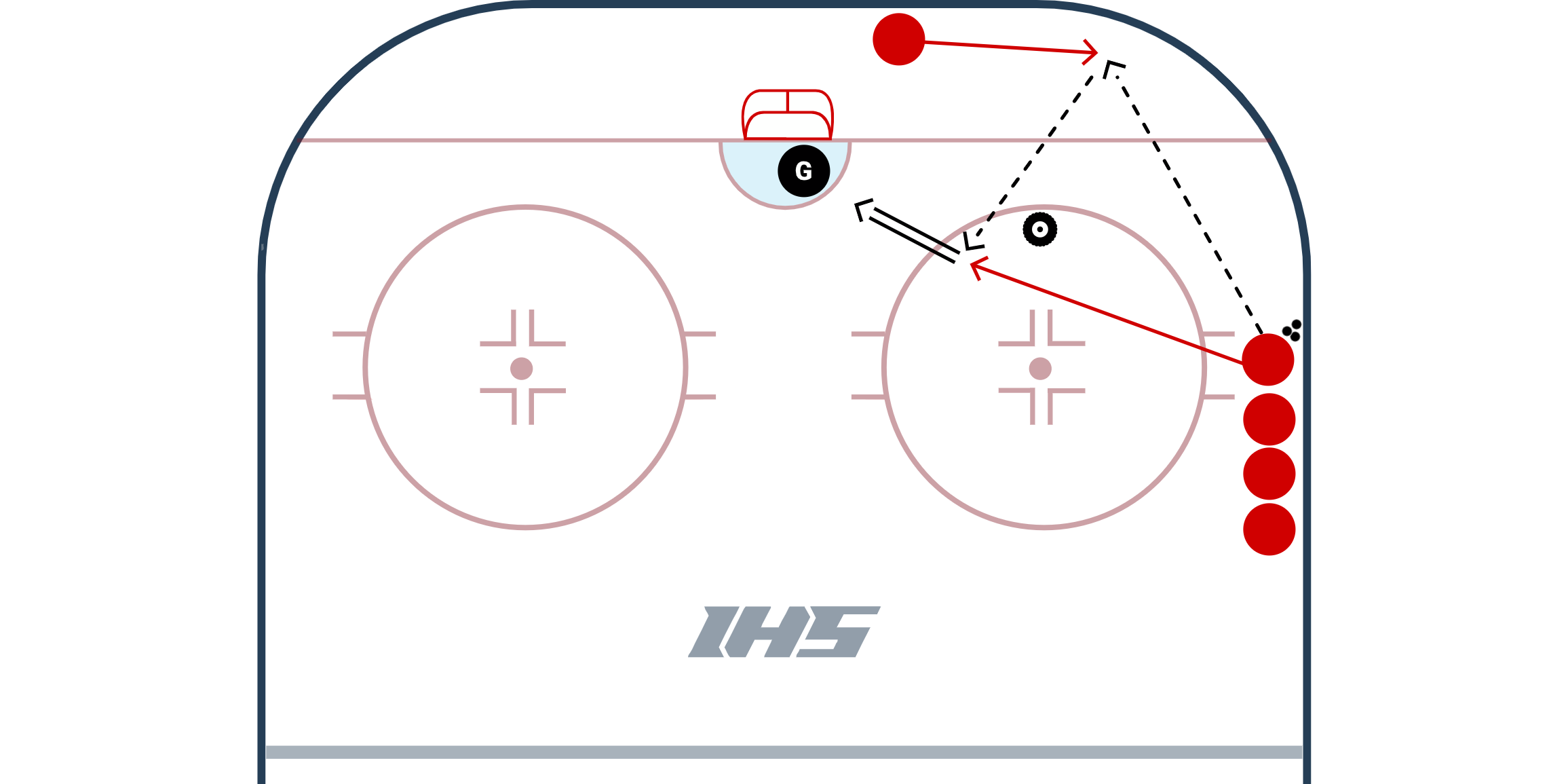
A great skill to help you increase your chances of scoring a goal is to learn how to quickly shoot off a pass! In video above, we show you a simple exercise to practice this skill by jumping to open space and getting off a quick shot. You can also set this drill up from the point.
Why is this skill beneficial? Alone, a quick-release shot can surprise the goaltender. However, if a quick-release shot comes off of a pass, it is even harder for a goalie to stop because they will be moving from wherever the pass came from.
The goal of this is concept is to get a goalie moving (from a pass) and getting a shot off quickly so the goalie does not have time to set up. On the flip side, if a player receives a pass, takes 2-4 seconds to settle the puck, the goalie has a better chance to get set up to make a save.
Setup:
- Players and pucks are lined up at the half-wall.
- A "Passer" is set up next to the net, by the near post.
- The "Passer" jumps to open space in the corner, which begins the exercise.
- Player # 1 passes the puck to the "Passer" in the corner.
- Player # 1 jumps to space heading to the net and receives a pass back. Player # 1 should work shoot quickly. Work on One Timers, or One Touch Shots to quickly get the puck off of your stick and to the net. Accuracy is not the key here, the goal is quick release. As time goes on, accuracy will come.
- The passer should be looking for rebounds after they pass the puck.
- After Player # 1 gets a shot off, they become the next passer.
- The Passer goes to the end of the line.
Coaching Points:
- Players should work on verbal (calling for the puck) & non-verbal communication (showing a target for the pass).
- Both Player # 1 and the Passer should work on quickly jumping to open space.
- Players should work on getting off a quick shot. They can also work on the following shots:
Goalie Notes:
- The goalie should not cheat and only line up for the shot. This is a great opportunity for the goalie to track the puck from the half wall, to the corner, to the slot.
Variations:
- Coaches can add various objects that the "Passer" must pass over or though. Make it more complex for higher skilled players.
- The coach can set up Player # 1 and the Passer to be in different areas of the ice to work on shooting off of a pass. For more skilled players you can work on greater passing distances and angles.
- You can Practice Shooting Off The Pass From The Point.
Shooting Off The Pass - Point
A great skill to help you increase your chances of scoring a goal is to learn how to quickly shoot off a pass! In the example above, we show you a simple exercise to practice this skill by jumping to open space and getting off a quick shot, coming down the wing. You can also set this up in the offensive zone corners.
Why is this skill beneficial? Alone, a quick-release shot can surprise the goaltender. However, if a quick-release comes off of a pass, it is even harder for a goalie to stop because they will be moving from wherever the original pass came from.
The goal of this is exercise is to get a goalie moving (from a pass) and getting a shot off quickly so the goalie does not have time to set up. On the flip side, if a player receives a pass, takes 2-4 seconds to settle the puck, the goalie has a better chance to get set up, get their angles correct and make the save.
Setup:
- Players and pucks are lined up at the point.
- A "Passer" is set up at the slot.
- The "Passer" jumps to open space to the point, which begins the exercise.
- Player # 1 passes the puck to the "Passer" at the point.
- Player # 1 jumps to space heading to the net and receives a pass back. Player # 1 should work shoot quickly. Work on One Timers, or One Touch Shots to quickly get the puck off of your stick and to the net. Accuracy is not the key here, the goal is quick release and hitting the net. As time goes on, accuracy will come.
- After Player # 1 gets a shot off, they become the next passer.
- The Passer goes to the end of the line.
Coaching Points:
- Players should work on verbal (calling for the puck) & non-verbal communication (stick on the ice showing a target for the pass).
- Both Player # 1 and the Passer should work on quickly jumping to open space.
- Players should work on getting off a quick shot. They can also work on the following shots:
Goalie Notes:
- The goalie should not cheat and only line up for the shot. This is a great opportunity for the goalie to practice their T-Pushes & Shuffles to track the puck from the point to the wing.
Variations:
- Coaches can add various objects that the "Passer" must pass over or though. Make it more complex for higher skilled players. You can even add a stick that players must pass over to practice their sauce.
- The coach can set up Player # 1 and the Passer to be in different areas of the ice to work on shooting off of a pass. For more skilled players you can work on greater passing distances and angles.
- Practice Shooting Off The Pass From The Corners
